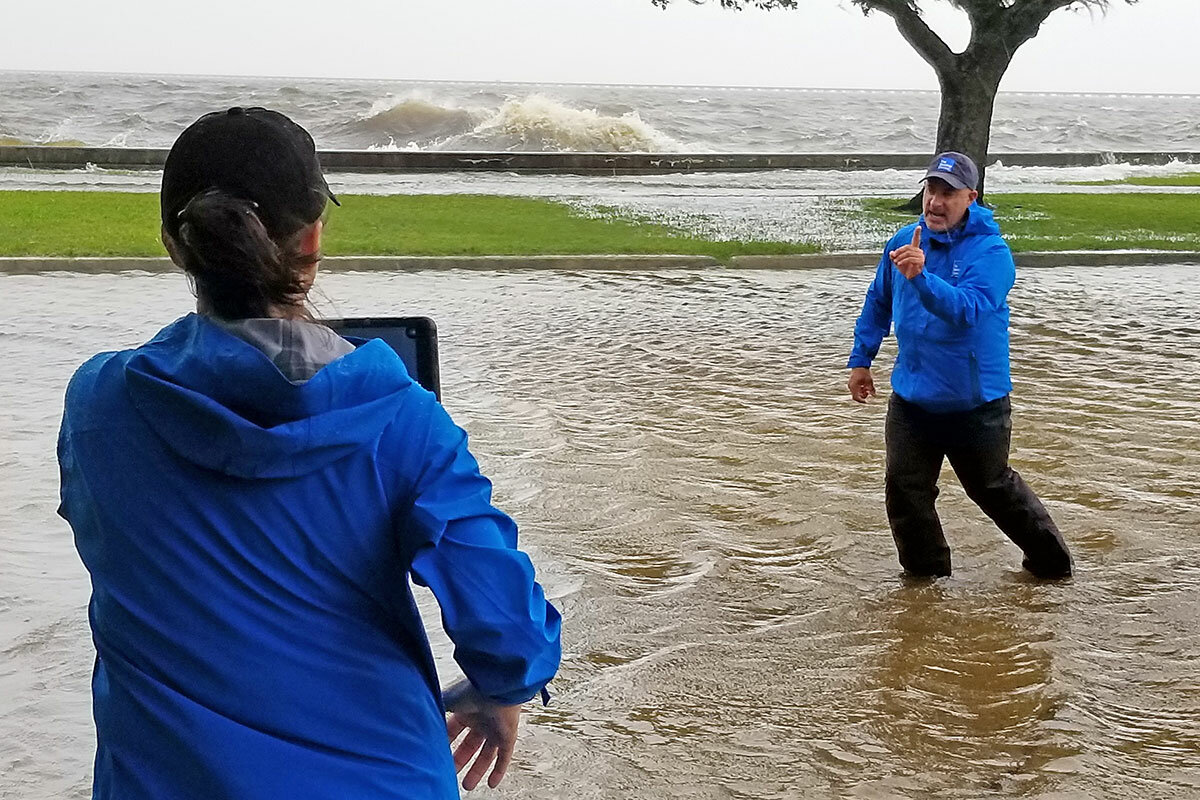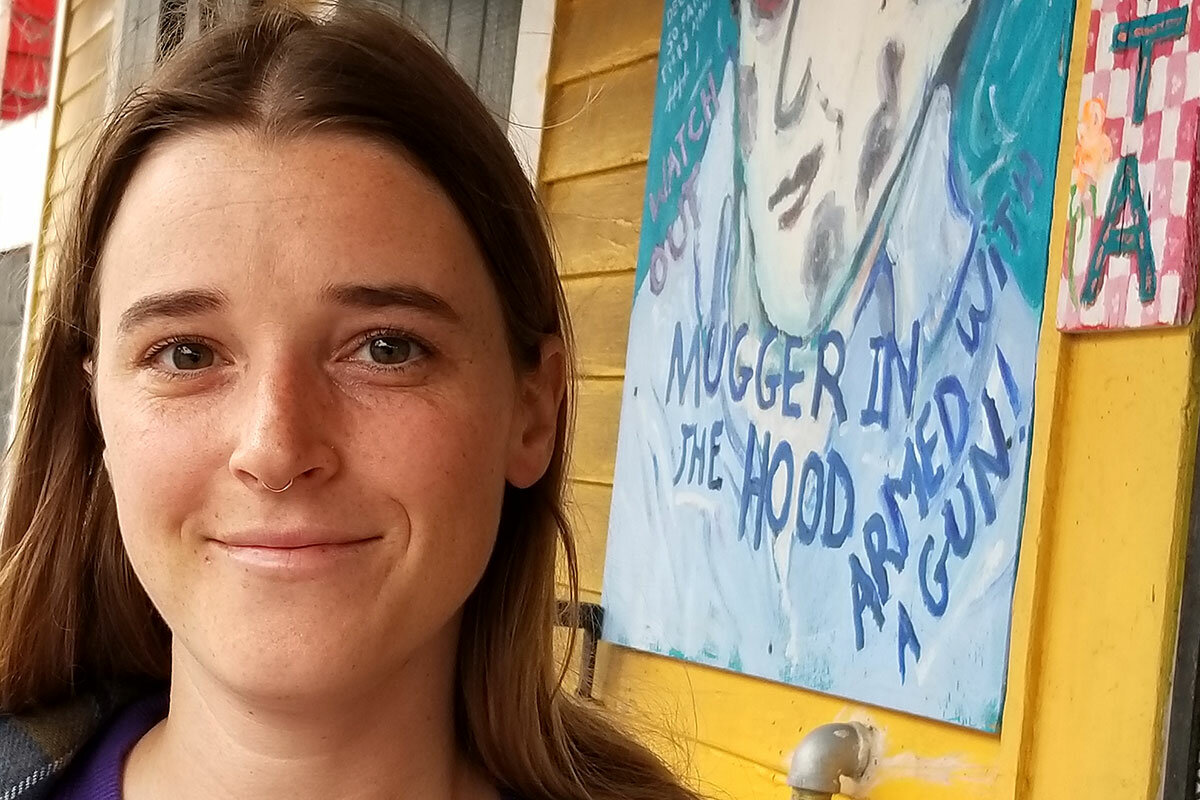After Barry, the Big Easy breathes easy
Loading...
| New Orleans
While national weather forecasters issued dire forecasts ahead of the storm, survivors of Hurricane Katrina like Lester Tobias tamped down panic. “I admit, sometimes I would get up and turn the TV off because I could feel the fear building,” he says “I just told myself: Chill.”
Some, like Charlene from Baton Rouge, railed against the “fake news mafia” that stirred up panic. But overall, a sense of thankfulness reigned. “We love this city, and we’ll fight for it,” says Claire Dahm. As part of that pride, many residents have become amateur “stormologists,” intently studying pump capacities, shear gradients, and levee topography.
Why We Wrote This
Thanks to a host of improvements and hard-won expertise, New Orleans remained calm and carried on during the breathless coverage of Tropical Storm Barry.
The confidence born of personal experience fueled a leveled response. Images of Lt. Gov. Billy Nungesser striding a levee in white shrimp boots summed up the local mindset.
As a result, officials issued largely voluntary evacuation orders. A push to open the Morganza Spillway was rejected. If panic had ruled, the state’s agriculture interests would have been flooded.
Instead, authorities “have been competent and communicative, providing just enough warning without being alarmist,” says Tulane Prof. Richard Campanella. “Likewise, the populace has been calm, cool, and collected.”
As Tropical Storm Barry crept closer to the Louisiana bayous, Lester Tobias, a French Quarter cook, steeled his nerves.
Fourteen years earlier, he stood on the Mississippi River levee and heard it break with a loud boom. Mr. Tobias fled as hundreds died in the flood waters of Hurricane Katrina.
For years, when he would hear rain in the night, he would get out of bed and stand at the window. “My wife would say, ‘What you jumping up for?’ I’d say, ‘I’m seeing if the water is going to rise.’”
Why We Wrote This
Thanks to a host of improvements and hard-won expertise, New Orleans remained calm and carried on during the breathless coverage of Tropical Storm Barry.
While national weather forecasters issued dire forecasts this weekend, New Orleanians like Mr. Tobias tamped down the panic. “I admit, sometimes I would get up and turn the TV off because I could feel the fear building. I just told myself: Chill.”
Some, like Charlene from Baton Rouge, railed against the “fake news mafia” that stirred up panic while the ground barely got wet. But overall, a sense of thankfulness reigned among a legion of storm-riders. “We love this city, and we’ll fight for it,” says Claire Dahm, who flew back to the city from Seattle to confront the hurricane. As part of that pride, many residents have become amateur “stormologists,” intently studying pump capacities, shear gradients, and levee topography.
The confidence of personal experience fueled a leveled response that contrasted starkly with national news coverage and anxiety among far-flung family and friends. Images of Lt. Gov. Billy Nungesser striding a levee in white shrimp boots summed up the local mindset in this city “floating below the surface of the water on a bed of mud,” as Benjamin Latrobe, America’s first architect, called it in 1819.
Richard Campanella, an expert on New Orleans' long flood-fighting tradition, referenced an article on the resiliency of civilians in New Orleans he wrote for Places Journal: “What the Nation’s Best-Educated Amateur Planners Learned from Hurricane Isaac. And Gustav. And Rita and Katrina. And Cindy, Ivan, Lili, Isidore, and Georges.”
As a result, he says, officials issued largely voluntary evacuation orders. A push to open the Morganza Spillway to relieve the Mississippi River was rejected – keeping the state’s agriculture interests from being flooded.
Instead, authorities “have been competent and communicative, providing just enough warning without being alarmist,” says Professor Campanella, author of “Bienville’s Dilemma” and a geography professor at Tulane University. “Likewise, the populace has been calm, cool, and collected.”
The Weather Channel’s Jim Cantore attempted to add some drama Sunday morning by standing in a puddle as lake waves crashed behind him in Mandeville, Louisiana. Off-camera, he admitted, “It’s over! Now it’s just ring around the rain bands.”
The city’s Twitter feed reprimanded one national newspaper for a breathless story on local anxiety that pictured not residents fleeing as the headline suggested, but two tourists lugging suitcases past Brennan’s Restaurant.
“Humans have a bit of morbidity in them: They want to see death and destruction,” a retired disc jockey explained during a call-in to a local radio station.
Faraway moms and dads can be forgiven for expecting the worst.
Barry was no joke. Yes, rainfall totals were way off – more like 2 inches than 20, as unexpectedly dry air sopped up the rain. But more than 100,000 people lost power, and a dozen had to be rescued from a remote island.
And as Bywater merchant Chet Gretna points out, the city was already on edge. A renegade thunderstorm drenched the city on Wednesday, leaving some folks swimming through the Irish Channel, which is a famed New Orleans neighborhood, not a waterway.
“A lot of people did get nervous about a storm on top of a storm,” says Mr. Gretna, a veteran hurricane rider.
New Orleanians are quick to point out that Katrina was no natural nightmare. It was a manmade disaster, with stumbles at every level. The greatest treachery was the failure of the levees themselves, the blame placed squarely on the Army Corps of Engineers, the federal agency that builds and maintains most of an elaborate levee system that fortifies the city.
But the trust has been built back, says Richard Jeffries, a retired meteorologist who attended insider briefings during Katrina, in part because of massive investment in the levee system and also better communication and increased transparency. During Katrina, he remembers officials would spend 40 minutes figuring out how to address rampant rumors that hobbled the response. This time, local researchers and journalists kept the government honest, at one point reporting on inconsistencies in levee height data, which the Corps investigated and corrected.
Ms. Dahm credits local authorities for holding detailed briefings that veered at key points into Spanish and Vietnamese to benefit the city’s two largest immigrant groups. “I felt like I was getting the best, most current information,” she says.
Sunday night, anxiety gave way to what this town does best: celebration.
At NOLA Comedy Night at the Hi-Ho Lounge, one of the comedians riffed, “In the end, we got what we wanted out of Barry: peace, happiness, and a gentle breeze.”










